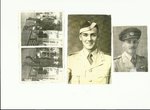biltongbru
Recruit
- 4
- Dec 24, 2009
In my quest to find and interview surviving ww2 fighter pilots I came across Cecil Golding and did this interview at his house during November 2011.
View: https://www.youtube.com/watch?v=KbWc-dZT74c
Animation is done with IL-2 flight sim
Cecil did service in the SAAF during ww2 from 1942- 1945.
He flew Curtiss Tomahawks in North Africa and was shot down claimed by Joachim Marseille. (Very much disputed rightfully by Cecil and South African historians!)
He later flew Spitfires in Malta, Sicily and Italy until the end of the war.
Cecil ended the war as a squadron leader and a DFC recipient.
I traced the stuka pilot in Austria and he also is still around. He sent me the photographs of himself that was shown in the video. An Internet connection was organised and the two gentleman had a good conversation the past Sunday.
Your questions to Cecil are welcome!

Cecil being commissioned and got his wings in 1941

Cecil with his Spit in Italy

On leave in South Africa

1945
View: https://www.youtube.com/watch?v=KbWc-dZT74c
Animation is done with IL-2 flight sim
Cecil did service in the SAAF during ww2 from 1942- 1945.
He flew Curtiss Tomahawks in North Africa and was shot down claimed by Joachim Marseille. (Very much disputed rightfully by Cecil and South African historians!)
He later flew Spitfires in Malta, Sicily and Italy until the end of the war.
Cecil ended the war as a squadron leader and a DFC recipient.
I traced the stuka pilot in Austria and he also is still around. He sent me the photographs of himself that was shown in the video. An Internet connection was organised and the two gentleman had a good conversation the past Sunday.
Your questions to Cecil are welcome!

Cecil being commissioned and got his wings in 1941

Cecil with his Spit in Italy

On leave in South Africa

1945

